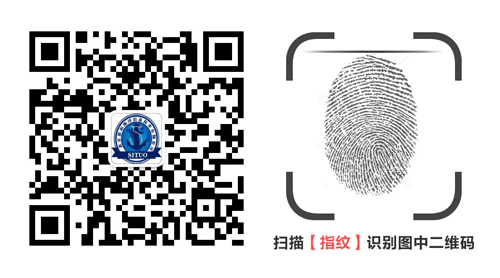电子图书出新通告 (2023.12.01)
发布时间:2023-12-01 17:22:12 访问次数:1218SeaReader电子阅读器为海上使用提供了一个完整的数字海洋技术库。它以易于使用的数字格式提供船上所需的所有书籍。它消除了维护纸质图书馆的相关成本和管理,因为所有数据都始终在容器上。此外,只需单击一个按钮,整个库就可以轻松更新。你甚至不需要在线更新数字图书馆。在船舶检查时,SPICA电子阅读器通过在船上提供所有强制性出版物,使检查变得简单,并确保合规性。有关IMO关于船舶出版物运输要求的更多信息和指南,请阅读(MSC-MEPC.2/Circ.2)
要使用多种数字出版物,请查看我们的软件SeaReader电子阅读器.
书名:List IV - List of Coast Stations and Special Service Stations - 2023 Edition
** THE CD IS THE NECESSARY ITEM FOR PORT INSPECTION **
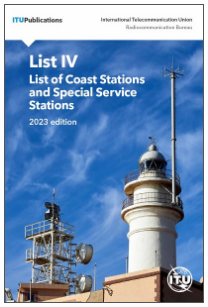
出版社-International Telecommunication Union
版本号-2023 Edition
语言- Arabic,Chinese,English,French,Russian,Spanish
书号 -ITU4000F
** THE CD IS THE NECESSARY ITEM FOR PORT INSPECTION **
List IV contains important information for mariners in relation to radiocommunications, including the Global Maritime Distress and Safety System (GMDSS). Detailed information, such as the frequencies for transmitting, receiving as well as the geographical coordinates, are provided for maritime coast stations, including those
assuming watch-keeping using digital selective calling (DSC) techniques and radiotelephony. List IV also provides details of additional services such as medical advice, navigational and meteorological warnings, Maritime Safety Information (MSI), Automatic Identification System (AIS), meteorological bulletins and radio
time signals, along with the hours of service and operational frequencies, as well as information on port stations, pilot stations, coast earth stations, Vessel Traffic Services (VTS) stations, contact information of (Rescue Coordination Centers (RCC), Search and Rescue (SAR) agencies, NAVAREA/METAREA coordinators and AIS Aids to Navigation (AToN).
As stipulated in Appendix 16 to the RR, this List shall be provided to all ship stations for which a GMDSS
installation is required by international agreement.
书名:Guidelines for Liquid Chemical Hose Management
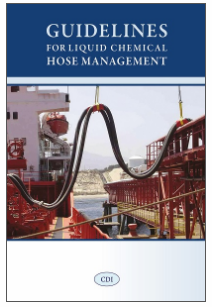
出版社-CDI - Chemical Distribution Institute
版本号-1st Edition
语言- English
书号 -CDI1100A
This publication provides an overview of the hoses used in production, transportation and storage of liquid chemicals, explaining their appropriate use and safe management. Product and service hoses used for water, steam, air and nitrogen are also covered.
This publication includes important safety and operational assessments that must be considered before hoses are chosen. ISO and EN standards outline hose manufacturing specifications and context is given on inherent hazards of application. The book includes maximum working pressure tables and technical diagrams that illustrate features such as flanges and end fittings. The chapter on maintenance and inspection informs readers on condemned hose features.
The purpose of this publication is to provide an overview of the various types of hoses used in the production, transportation and storage of liquid chemicals. It also explains their appropriate use and safe management. While the main focus is on the hoses used for the transfer of chemical products, the essential and frequently used range of service hoses for water, steam, air and nitrogen are also covered.
While this publication may make short references to transfer hoses for oil products, in no way does it set out to challenge the industry standards that exist for the specialist hoses used for oil transfers in the many different operating environments.
Product and service hoses form an integral part of transfer operations, and their choice and use must be based on assessments that cover appropriate use, safety and operational efficiency.
The use of hoses is only recommended where fixed rigid piping is either not suitable or is impractical for the operation taking place.
The range of hoses can vary from those that convey products to those that provide standalone services, or provide services forming part of an integrated product or vapour transfer system. They can be installed on a semi-permanent single or multi-use basis, or be individual hoses that are transferred to the point of use and only connected as and when required.
Depending on the product or service hazards and the location and nature of the application, the risks involved, and the subsequent hose choice, installation, control, use, training and maintenance, will vary. A hose management system with policies and procedures that are based on risk assessments and operability studies should be developed and implemented to ensure the safe and effective use of hoses.
Operational characteristics, including the degree of automation and type of manual tasks conducted, will impact on the policies and procedures that need to be developed and implemented.
To ensure safe and efficient use, procedures need to be implemented for the proper cleaning, inspection, testing and maintenance of the hoses and end fittings. The procedures should include the associated handling and monitoring equipment, such as lifting and support equipment and temperature and pressure gauges.
Product and service hoses may be supplied and/or used by external parties such as road, rail or ship carriers, cleaning contractors or other parties. Appropriate procedures, operational agreements and controls should be in place to ensure that hoses supplied by external parties meet the same standards as those set by the hose management system.
All personnel involved in purchasing, handling, cleaning, testing and maintaining hoses must be suitably trained and experienced in the use of hoses, the risks involved and the controls required.
书名:Lloyd's Maritime Atlas 2024-2025
of World Ports and Shipping Places
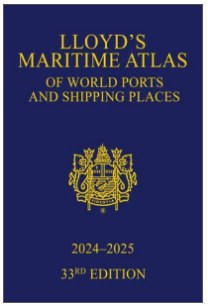
出版社-Informa
版本号-33rd Edition (2024-2025)
语言- English
书号 -TAF7500AG
Welcome to the 33rd edition of Lloyd’s Maritime Atlas.
Published since 1951, Lloyd’s Maritime Atlas is the oldest and most respected atlas in the shipping industry. A comprehensive reference for locating the world’s busiest ports and shipping places, this new edition has been fully updated and enhanced with revised maps and new features to alleviate the demands on today’s busy shipping professional.
In the 2024–2025 edition you will find:
The maps and indexes have been updated with the latest port names and locations, and expanded with almost 200 new ports integrated
The addition of more than 400 new anchorages, 45 marine terminals, 22 offshore facilities, and 85 oil and gas fields
The latest data on piracy incidents applied to a global overview with summaries by region, vessel type and dwt, plus every map featuring three grades of incident symbols to highlight the severity of different hotspots
The MARPOL map has been separated from PSSA and SECA for increased clarity, with new Mediterranean Sea areas for SECA and PSSA integrated
An updated world map of vaccinations required to protect against major global diseases
The very latest Marine Distance Tables and fleet statistics
In addition, Lloyd’s Maritime Atlas continues to provide:
Precise latitude and longitude co-ordination of more than 9,000 ports and shipping places around the world
More than 70 full-colour world, ocean, and regional maps
A global overview of international load line zones
An expansive double-page world distance table plus 33 detailed regional tables to help you plan your route
A unique and extensive geographical and alphabetical indexing system to help readers quickly and easily find a location
All major canal and river systems, plus main road, rail, and airport connections to cater for multi-modal journeys
This book continues to be the premier reference guide for shipping professionals worldwide.
书名:CDI Best Practice Recommendations Regarding the use of Nitrogen
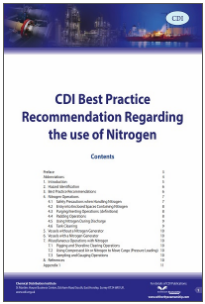
出版社-CDI - Chemical Distribution Institute
版本号-1st Edition
语言- English
书号 -CDI3000A
This publication is a guide to best practice recommendations for the use of nitrogen on board chemical tankers.
This guide to the use of nitrogen on board chemical tankers outline best practice recommendations and covers topics including:
1.Hazard identification
2.nitrogen operations (including entry into enclosed spaces, purging/inerting and tank cleaning)
3.vessels with a nitrogen generator
4.vessels without a nitrogen generator
5.miscellaneous operations.
The purpose of this document is to provide the chemical industry best practice recommendation for consideration during the inerting process and future revisions of legislation and industry guidelines. In addition, this document is directed towards any party involved with tank ships carrying chemicals, including, but not limited to, vessel personnel, shore personnel, surveyors, inspectors and charterers. This document will be periodically reviewed by CDI.
While not directed towards other vessel types, much of the information included here may be applicable when nitrogen is used. Any person who affects the policies, procedures or processes used in the carriage of chemicals should understand the implications of using nitrogen on board the vessel.
It is expected that the use of nitrogen will increase within the maritime industry (both ashore and on board), and this could lead to an increase in nitrogen related incidents if not properly managed. It is recognised that implementation of the recommended best practice could impact upon the commercial and operational aspects of both vessels, terminals, and
the industry as a whole which could lead to other changes within the industry to help mitigate these impacts. As nitrogen generators on board chemical tankers become more prevalent, it could allow further alternatives to address these emerging issues.
Flue gas (inert gas generated through combustion of fuels) was introduced on-board large tank vessels by the oil industry as a barrier to tank explosions by reducing the tank's oxygen content safely below that level needed to support combustion. Rules governing the installation and operation of inert gas systems were subsequently developed by IMO under the SOLAS convention. Due to the high quality requirements for many chemicals, flue gas was not deemed suitable for use on chemical tankers which were exempt from having to comply with the SOLAS IG rules providing certain conditions were met. With the development of efficient nitrogen generators chemical tankers began to be fitted, or retrofitted, with this equipment. Many of these units were sized and installed for use in padding and topping up (and thus, of insufficient capacity to inert cargo tanks as they are being discharged), but it is expected that as the industry moves towards the greater use of nitrogen, more and more of these systems will be of sufficient capacity for this use, which potentially creates additional issues to be addressed. As it is recognised that vessels without a nitrogen generator can still be exposed to nitrogen through other sources (i.e. shore-supplied nitrogen, nitrogen bottles, etc.), this document also provides general precautions regarding nitrogen operations on-board vessels that do not have a nitrogen generator.
Nitrogen has been in use for many years on chemical tankers to reduce the oxygen content in empty tank spaces (and even occasionally adjacent void spaces) when carrying certain chemicals, which can be adversely affected by Oxygen. This is done either for safety reasons, such as to prevent a flammable atmosphere from developing (e.g. Propylene Oxide), for cargo quality reasons (e.g. Hexene 1 or Hexamethylene Di Amine), and for other uses on the vessel (e.g. cargo handling, or inerting void spaces or cofferdams).
Nitrogen is 78% part of the atmosphere, (with the remainder consisting of 21% Oxygen and 1% others) and is consequently undetectable to human senses.
Increased CO2 concentration in a person's lungs is the biological trigger to inhale; nitrogen asphyxiation kills by eliminating that trigger.
书名:Chemical Tankers: A Pocket Safety Guide
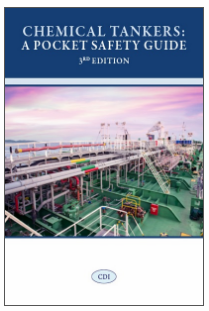
出版社-CDI - Chemical Distribution Institute
版本号-3rd Edition
语言- English
书号 -CDI1000C
This book provides best practice guidance for tankers carrying chemical and similar hazardous products. It is a good introduction to safe tanker practice, terminology and standards, and is a useful tool to crew members with little to no practical experience.
This book is listed as a "Publication required to be onboard" in the CDI Ship inspection questionnaire.
This book should be used in addition to the International Safety Management (ISM) Code, which sets standards for the company's safety management system (SMS) and operating manuals. These standards must be followed carefully as they provide the details and procedures essential to safe work at sea.
The Guide features information necessary to carry out basic tasks safely and details potential hazards, what to do if a problem arises, and how to mitigate the risks through best practice. A glossary of technical terms is included, with graphical representation of more complex concepts.
This book explores best practices on tankers carrying chemical and similar hazardous products and provides a good introduction to safe tanker practice, terminology and standards. It is not a detailed operational guide, but is aimed as basic safety information for seafarers of all ranks and positions. It is suitable for seafarers who may be rejoining a tanker after leave for example, or for a person with little or no experience on tankers, in particular cadets and new ratings. Ideally, it should be read to aid the familiarisation process whenever you join a tanker.
The International Safety Management (ISM) Code sets standards for your company's safety management system (SMS) and operating manuals. These will provide the details and procedures to allow you to work safely at sea, so you must follow them carefully. This book is an addition to these standards and not an alternative to them.
As a crew member working with dangerous cargoes, you should have a clear understanding of operations on board a tanker. Therefore, you are encouraged to seek further information and detail beyond the overview of subjects given here. In particular, you should read the CDI publication 'Bulk Liquid Chemical Handling Guide for Plants, Terminals, Storage and Distribution Depots (BLCH Guide)'.
Not all of the cargoes carried on chemical tankers are hazardous. However, most do have some level of safety and/or pollution hazard connected to them. The marine industry recognises this and, through design, regulation and best practice, has controlled or removed many of the hazards.
When reading this book, you may find terms that are new to you. A glossary of technical terms is provided at the end and you should refer to this if you are uncertain about meanings. If you are still unsure, ask a senior officer or other responsible member of the crew.
书名:Brown's Compact Nautical Almanac 2024

出版社-Brown, Son & Ferguson
版本号-147th - 2024 Edition
语言- English
书号 -BSF2100EQ
Brown's Nautical Almanac in a Compact edition, contains less information than the standard Brown's Nautical Almanac.
Following is included in the Compact Edition:
1.Calendar for the year 2024 & 2025
2.Phases of the moon.
3.Eclipse
4.Explanation of Astronomical characters
5.Altitude correction tables
6.The Nautical Almanac and its use
7.Planetary information, 2022
8.Hourly Astronomical elements of sun, moon and planets
9.Standard times
10.Increments and correction tables
11.Sidereal hour angle and declination of stars
12.Polaris (pole star) tables, 2022
13.How to find the principal stars
14.Legal guidance for the mariner
15.Load line zones, areas and seasonal periods
16.International regulations for preventing collisions at sea
书名:Brown's Nautical Almanac 2024
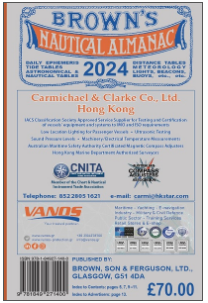
出版社-Brown, Son & Ferguson
版本号-147th Edition
语言- English
书号 -BSF2000EQ
Browns Nautical Almanac is the oldest Nautical Almanac totally produced in Britain. It is highly respected within all shipping circles and should always be to hand anywhere in the world every day throughout the year. The contents, which are updated and added to each year are full of information regularly consulted by ship builders, repairers, ship owners, marine superintendents, shipmasters, ships officers, harbour authorities and yachtsmen. Brown Nautical Almanac is now in its 147th year of publication.
Brown, Son and Ferguson Ltd. is proud to announce that the 2024 publication of Brown's Nautical Almanac will be the 147th Edition.
Established in 1850 on the south side of the River Clyde in Glasgow, Brown, Son and Ferguson Ltd. soon started to publishing books for the sailing ships that visited the city. In these early days there were few publications on maritime affairs available and its range of titles steadily grew.
A new exciting era dawned for the firm with the first issue of Brown's Nautical Almanac in 1876. Every year it continues to be completely revised with ongoing care and attention given to its preparation. It has been edited and arranged to ensure accuracy and ease of reference for a book in daily practical use. The entire book has been re-set so that Navigators will find the tables are sharper and easier to read.
Completely revised each year. Well known in every port throughout the world. Published annually in October for the following year.
True Rhumbline Distance (WGS-84 Calculations (13 pages), Trans-oceanic Passages by Rhumbline Sailing - Method A1NA2, Difference in Nautical Miles between True Rhumbline Distance (WGS-84) and GPS Rhumbline Distance, Distance Correction for Converting Theoretical (Sphere) into Correct Practical Great Circle Distances, Correct (accurate) Mercator Chart (WGS-84) Construction, Trim Calculations. Metacentric Height and List Calculations, with List Draft Changes, etc.
Draft Surveying and Displacement Calculations (5 pages), How to get Trim and Drafts Forward and Aft by Distance between Longitudinal Centres of Buoyancy and Gravity, Tank's Vertical Centre of Gravity, Free Surface in the Tank, Useful Information for Safety of Navigation and a Ship, Sailings, Great Circle Sailing, Differences in Nautical Miles between Great Circle Distance (Sphere) and Theoretical Geodesic Curve Distance (Spheroid, WGS-84), etc.
The Almanac is arranged in parts that are numbered for ready reference from I to VII as follows:- I, Astronomical data in daily use by navigators, explanations of its use. II, Nautical Tables and Methods. III, Tide Tables for Home and Foreign Waters. Predictions have been compiled by the most reliable authorities as acknowledged. The Tidal Constants for British Isles and Foreign Ports. IV, Coastal Courses and Distances around the British Isles. Courses are given Correct Magnetic (2020) and in True (3-figure) notation. Distances are given to the nearest 0.25 of a mile. The Table of Courses and Distances around the British Isles, North Sea, English Channel and the Baltic Ports. V, Distance Tables giving a world-wide coverage of total distances from the principal ports of Britain, U.S.A. and Canada, to all important ports of the world.
Numerous other tables give inter-port distances in the important areas. VI, Miscellaneous Information, Legal, Technical and General. VII, Lights, Beacons and Buoys of the British Isles including Eire and Channel Isles. Pilotage information. A mass of Valuable Matter for the Merchant Navy, Yachtsmen, Shippers, Shipping Offices, etc. Used round the world every day throughout the year.
Also includes fully updated Offshore Installations for both wind farms and oil rigs around the coast of the UK and updated meteorological information.
书名:Código IMSBC y Suplemento Edición de 2023
Incluida la Enmienda 07-23
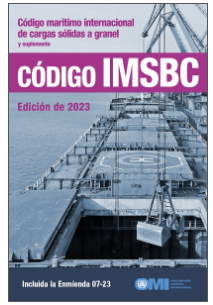
出版社-International Maritime Organization
版本号-2023 Edition
语言- Spanish
书号 -IMO260M-ES
Edición de 2023 IMSBC Código marítimo internacional de cargas sólidas a granel y suplemento Incluida la Enmienda 07-23
Spanish Language
The International Maritime Solid Bulk Cargoes Code (IMSBC Code), adopted on 4 December 2008 by resolution MSC.268(85), entered into force on 1 January 2011, from which date it was made mandatory under the provisions of the SOLAS Convention. The present edition incorporates Amendment 07-23, which may be applied from 1 January 2024 on a voluntary basis, anticipating its envisaged official entry into force on 1 January 2025.
This publication also presents additional information that supplements the IMSBC Code, such as the Code of Practice for the Safe Loading and Unloading of Bulk Carriers (BLU Code, including BLU Manual) and Recommendations on the safe use of pesticides in ships applicable to the fumigation of cargo holds. The IMSBC Code and supplement is commended to Administrations, shipowners, shippers and masters and all others concerned with the standards to be applied in the safe stowage and shipment of solid bulk cargoes, excluding grain.
书名:Engins de sauvetage y compris le Recueil LSA édition de 2023
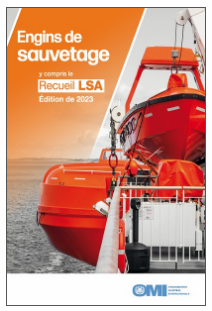
出版社-International Maritime Organization
版本号-2023 Edition
语言- French
书号 -IMO982G-FR
This publication contains the three most important IMO instruments dealing with life-saving appliances, as updated, namely the International Life-saving Appliance (LSA) Code (resolution MSC.48(66)), the Revised recommendation on testing of life-saving appliances (resolution MSC.81(70)) and the Code of practice for evaluation, testing and acceptance of prototype novel life-saving appliances and arrangements (resolution A.520(13)).
书名:Model Course 2.03 Advanced training in fire fighting
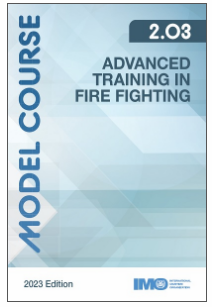
出版社-International Maritime Organization
版本号-3rd Edition 2023
语言- English
书号 -IMOMC203C
This course covers training in fire fighting and is based on the provisions of table A-VI/3 of the STCW Code.
书名:Reeds Nautical Almanac 2024
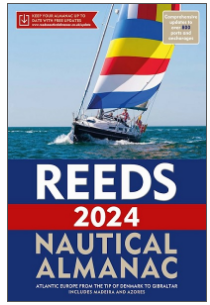
出版社-Adlard Coles Nautical
版本号-2024 Edition
语言- English
书号 -BLO0024A
Reeds Nautical Almanac is the indispensable trusted annual compendium of navigational data for yachtsmen and motorboaters, and provides all the information required to navigate Atlantic coastal waters around the whole of the UK, Ireland, Channel Islands and the entire European coastline from the tip of Denmark right down to Gibraltar, Northern Morocco, the Azores and Madeira.
Having celebrated its 91st anniversary edition last year, the 2024 Almanac continues the tradition of year on year improvement and meticulous presentation of all the data required for safe navigation. Now with an improved layout for easier reference and with over 45,000 annual changes, it is regarded as the bible of almanacs for anyone going to sea.
The 2024 edition is updated throughout, containing over 45,000 changes, and includes: 700 harbour chartlets; tide tables and tidal streams; buoyage and lights; 7,500 waypoints; invaluable passage notes; distance tables; radio, weather and safety information; first aid section. Also: a free Marina Guide.
书名:Dispositivos de salvamento Edición de 2023 Incluido el Código IDS
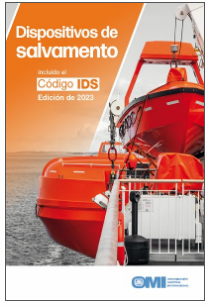
出版社-International Maritime Organization
版本号-2023 Edition
语言- Spanish
书号 -IMO982G-ES
SeaReader eBook: Dispositivos de salvamento Edición de 2023 Incluido el Código IDS
(Life-Saving Appliances inc. LSA Code, 2023 Edition Spanish-language)
Esta publicación contiene los tres instrumentos más importantes de la OMI en materia de salvamento, a saber, el Código Internacional de dispositivos de salvamento IDS (en inglés Life-Saving Appliances LSA), la Recomendación revisada sobre las pruebas de los dispositivos de salvamento y el Código de prácticas para la evaluación, prueba y aceptación de prototipos de vida de dispositivos de salvamento.
更多信息请联系:
北京思拓海洋信息技术有限公司
北京市丰台区汽车博物馆东路6 号院盈坤世纪大厦 F 座 512室
电话:010 62680730
传真:010 62681683
邮箱:sales@enclive.cn
